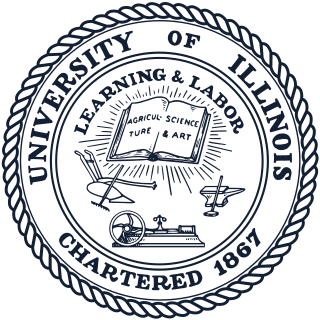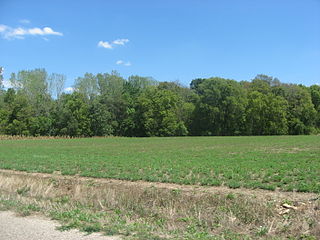Related Research Articles

Vermilion County is a county in the eastern part of the U.S. state of Illinois, between the Indiana border and Champaign County. It was established in 1826 and was the 45th of Illinois' 102 counties. According to the 2020 United States census, it had a population of 74,188. It contains 21 incorporated settlements; the county seat and largest city is Danville.

Urbana is a city in and the county seat of Champaign County, Illinois, United States. As of the 2020 census, Urbana had a population of 38,336. It is a principal city of the Champaign–Urbana metropolitan area, which had 236,000 residents in 2020.

The University of Illinois System is a system of public universities in the U.S. state of Illinois consisting of three universities: Chicago, Springfield, and Urbana-Champaign. Across its three universities, the University of Illinois System enrolls more than 94,000 students. It had an operating budget of $7.18 billion in 2021.

The University of Illinois Urbana-Champaign is a public land-grant research university in the Champaign–Urbana metropolitan area, Illinois, United States. It is the flagship institution of the University of Illinois system and was established in 1867. With over 53,000 students, the University of Illinois is one of the largest public universities by enrollment in the United States.

The Champaign–Urbana metropolitan area, also known as Champaign–Urbana and Urbana–Champaign as well as Chambana (colloquially), is a metropolitan area in east-central Illinois. As defined by the Office of Management and Budget (OMB), the metropolitan area has a population of 236,514 as of the 2022 U.S. Census, which ranks it as the 200th largest metropolitan statistical area in the U.S. The area is anchored by the principal cities of Champaign and Urbana, and is home to the University of Illinois Urbana-Champaign, the flagship campus of the University of Illinois system.

The National Historic Preservation Act is legislation intended to preserve historic and archaeological sites in the United States of America. The act created the National Register of Historic Places, the list of National Historic Landmarks, and the State Historic Preservation Offices.
The Illinois Historic Preservation Division, formerly Illinois Historic Preservation Agency, is a governmental agency of the U.S. state of Illinois, and is a division of the Illinois Department of Natural Resources. It is tasked with the duty of maintaining State-owned historic sites, and maximizing their educational and recreational value to visitors or on-line users. In addition, it manages the process for applications within the state for additions to the National Register of Historic Places.

The Naples Mound 8 is a Havana Hopewell culture mound site located in Pike County, Illinois three miles east of the city of Griggsville. It is the largest mound on the bluff-top in the lower Illinois Valley. The mound was given the name Naples Mound #8 in 1882. The mound was listed on the National Register of Historic Places in 1975.

The New Philadelphia National Historic Site is the original site of the now-vanished town of New Philadelphia, Illinois, in the United States. It is located near the western Illinois city of Barry, in Pike County.

The Stoner Site is a substantial archaeological site in the far eastern portion of the U.S. state of Illinois. Discovered during the Great Depression, the site has produced large numbers of artifacts from a prehistoric village that was once located there, and archaeological investigations have shown it to be one of the area's most important archaeological sites for the Allison-Lamotte culture. After more than a decade of fruitful research and predictions of potentially rich results from future work, it has been designated a historic site.

The Pierre Menard House, located in Ellis Grove, Illinois, United States, was the home of Pierre Menard, a trader who became the first lieutenant governor of Illinois from 1818 to 1822.
Christopher C. Fennell is an American anthropologist and lawyer, an Assistant Professor of Anthropology at the University of Illinois, Urbana-Champaign. His first book Crossroads and Cosmologies: Diasporas and Ethnogenesis in the New World (2008) received the John L. Cotter Award from the Society for Historical Archaeology. Fennell is editor of the African Diaspora Archaeology Network and Newsletter, and an associate of the editorial board of the International Journal of Historical Archaeology.

The Illinois Fighting Illini baseball team is the varsity intercollegiate athletic team of the University of Illinois Urbana-Champaign in Champaign, Illinois, United States. The team competes in the National Collegiate Athletic Association's Division I and are members of the Big Ten Conference.

A volume is a physical book. It may be printed or handwritten. The term is commonly used to identify a single book that is part of a larger collection. Volumes are typically identified sequentially with Roman or Arabic numerals, e.g. "volume III" or "volume 3", commonly abbreviated to "Vol.".
The Advisory Council on Underwater Archaeology (ACUA) serves as an international advisory body on issues relating to underwater archaeology, conservation, and submerged cultural resources management. It works to educate scholars, governments, sport divers, and the public about underwater archaeology and the preservation of underwater cultural heritage. The ACUA is an independent, non-profit organization closely affiliated with the Society for Historical Archaeology (SHA). The ACUA helps the SHA Conference Committee to organize the annual SHA Conference on Historical and Underwater Archaeology and provides continuing education through workshops and panel discussions.
Edward Baker Jelks was an American archaeologist trained as a prehistorian yet known for his contributions to historical archaeology and leadership roles in multiple anthropological organizations, including the Society for Historical Archaeology and the Society of Professional Archaeologists.
The Prairie Research Institute is a multidisciplinary research institute charged with providing objective research, expertise, and data on the natural and cultural resources of Illinois. It was established as a unit of the University of Illinois at Urbana-Champaign by a Public Act of the Illinois State Legislature in 2008. The institute comprises four state scientific surveys: the Illinois Natural History Survey (INHS), the Illinois State Archaeological Survey (ISAS), the Illinois State Geological Survey (ISGS), and the Illinois State Water Survey (ISWS), and the institute also houses the Illinois Sustainable Technology Center (ISTC). The institute has a combined total staff of more than 700 employees, with facilities located on the Urbana-Champaign campus of the University of Illinois, and field offices and research stations throughout the state.
A Smithsonian trinomial is a unique identifier assigned to archaeological sites in many states in the United States. They are composed of one or two digits coding for the state, typically two letters coding for the county or county-equivalent within the state, and one or more sequential digits representing the order in which the site was listed in that county. The Smithsonian Institution developed the site number system in the 1930s and 1940s, but it no longer maintains the system. Trinomials are now assigned by the individual states. The 48 states then in the union were assigned numbers in alphabetical order. Alaska was assigned number 49 and Hawaii was assigned number 50, after those states were admitted to the union. There is no Smithsonian trinomial number assigned for the District of Columbia or any United States territory.

The Cattle Bank is a historic bank building located at 102 E. University Ave. in Champaign, Illinois. Built in 1858, it is the oldest documented commercial structure in Champaign. It opened as a branch of the Grand Prairie Bank of Urbana, Illinois. Champaign was the southern terminus of a railroad line to Chicago, so cattle raisers from the surrounding area drove their cattle to Champaign to ship them to the Chicago market. The Cattle Bank provided banking and loan services to these cattlemen. The building housed a bank for only three years. During that time, U.S. President Abraham Lincoln is known to have cashed a check there. From 1861 to 1971, the building housed several commercial tenants. It was added to the National Register of Historic Places in 1975 and renovated in 1983. Since 2001, the Cattle Bank has been home to the Champaign County History Museum.

The history of the University of Illinois Urbana-Champaign dates back to 1862. U of I is a public research-intensive university in the U.S. state of Illinois. A land-grant university, it is the flagship campus of the University of Illinois system. The University of Illinois Urbana-Champaign opened on March 2, 1868, and is the second oldest public university in the state, and is a founding member of the Big Ten Conference.
References
- ↑ "Our History". Illinois State Archaeological Survey. Archived from the original on 27 February 2013. Retrieved 13 May 2013.
- ↑ https://www.ideals.illinois.edu/bitstream/handle/2142/129/1956_Urbana_Archaeological.pdf?sequence=2&isAllowed=y [ bare URL PDF ]
- ↑ "They Came, They Saw, They Surveyed - Historic Places".
- ↑ "Awareness Month".
- ↑ "The Illinois Bicentennial: 200 Years of Discovering and Preserving Our History". The Illinois Bicentennial.
- ↑ https://ilarchsurv.org/resources/Documents/AM2018_reverse.jpg [ bare URL image file ]
- ↑ "Videos".